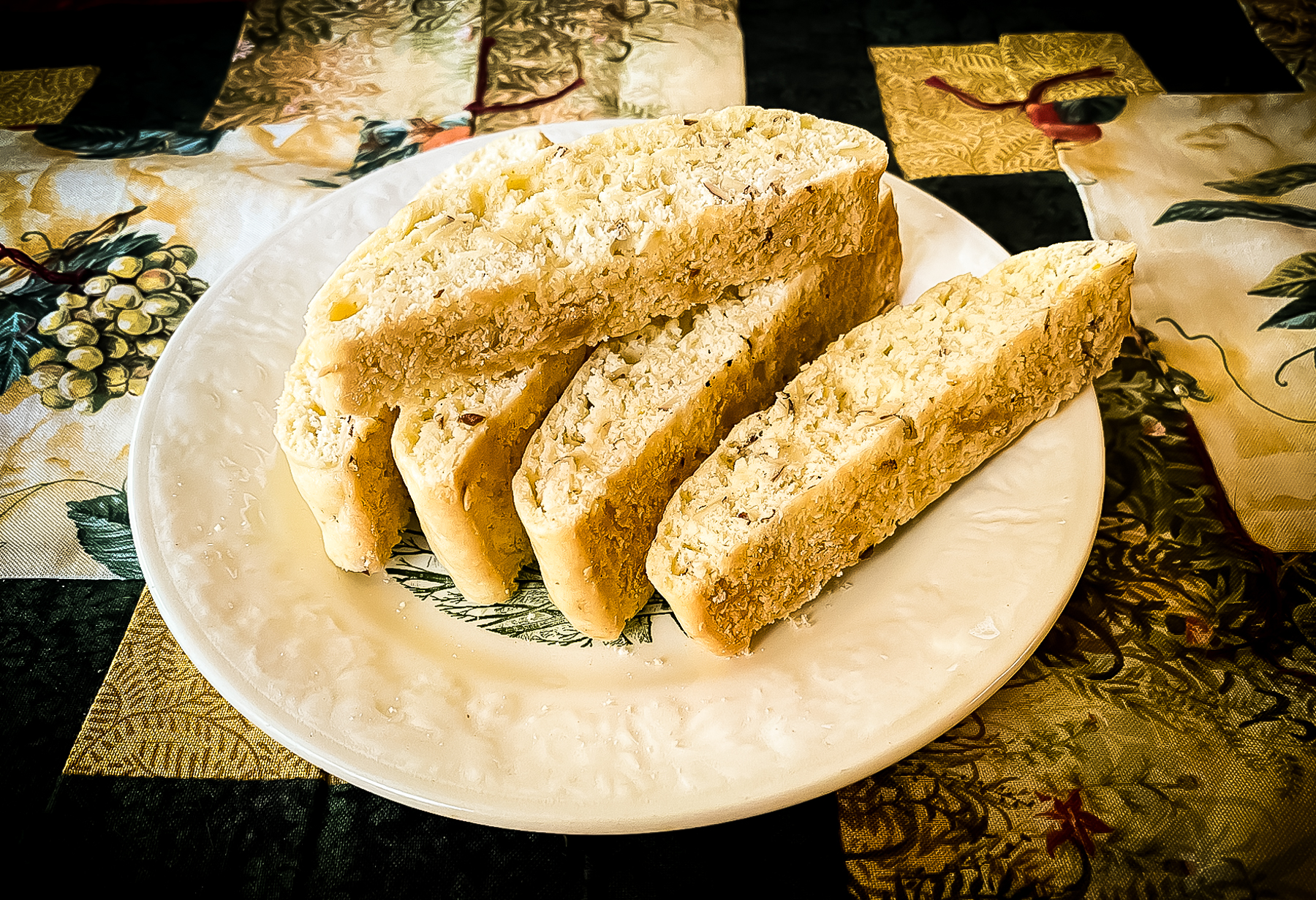“If more of us valued food and cheer and song above hoarded gold, it would be a merrier world.”
J.R.R. Tolkien, The Hobbit
The fragrance of orange, almond, and nutmeg waft through the house, luring my kids from bed early in the morning. This aroma has been an integral part of our family’s holiday season since before the kids were born. It’s biscotti day, the special time each December when I devote a day to baking batch after batch of biscotti. These Italian cookies will be tucked into festive baggies for gift-giving and placed on a china dish for snacking, to dip in a cup of coffee or rich hot cocoa. This delicious smell, which is a harbinger of the coming holidays, is the surest sign in our house that Christmas is just around the corner.
Sweet scents and buttery hands take me back to when I was little and my mom participated in the popular party of the 1970s — the cookie exchange. When mom pulled that slightly dented tin cookie press off of the top shelf, the joy and wonder of the season began in a cloud of flour and sprinkles. Mom dedicated a day to making spritz cookies, squeezing that stiff dough through the tiny holes in the cookie press into the shapes of trees, wreaths, and snowflakes. My task was to add colored-sugar sprinkles or those wee, silver-coated nonpareils. Forming the cookies was a two-person task because the dough was chilled and the press was small. This would lead to cramping hands and a mildly churlish attitude about the entire process, so my parents would trade-off extruding the dough. A cookie exchange party requires baking dozens of one kind of cookie, then plating and bagging a dozen per attendee with an additional dozen for serving at the party. Multiply dozens of cookies by three events and one can understand why baking was an all-day occasion. If only we had known about the ease of biscotti!
This is the traditional Italian biscotti recipe that I began baking when I was short on finances but long on Christmas joy with the love of sharing home-baked treats. (In fact, this biscotti was shared at a cookie exchange or two when I was first married.) What could I offer to my friends and family that would be a little different than the typical Christmas cookie? I needed an option that would bake up quickly and keep well. Unlike store-bought biscotti slices, which are rock hard, this homemade biscotti is an ideal dunker with a dry but tender crumb. My recipe can be double-batched; in fact, that is what I always do. I set aside (and my family happily anticipates!) ‘biscotti day’ in December and bake several batches in a single day. The kitchen is filled with warm smells of almond and spices, and the tables are covered with bowls heaped with biscotti just waiting to be shared.
Biscotti Toscani
The ingredients:
½ c. sliced almonds
1/3 c. softened butter
¾ c. sugar
2 eggs
1 tsp. vanilla extract
1/2 tsp. almond extract
2 tsp. grated orange zest
2 ¼ c. all-purpose flour
1 ½ tsp. baking powder
¼ tsp. nutmeg
¼ tsp. salt
The process:
Place almonds on a shallow pan or cookie sheet and bake in a preheated 325-degree oven until golden brown, about 6-8 minutes, taking care that they don’t overbake. Remove from oven and set aside to cool.
In a mixing bowl, cream butter and sugar until light and fluffy. Beat in eggs, vanilla, almond extract and orange zest.
In another bowl, combine the flour, baking powder, nutmeg, and salt. Add to creamed mixture, mixing until blended.
Fold in almonds.
Divide dough in half and place both on a greased baking sheet.
Wet hands with a little water and form dough into two logs about 1 inch thick, 3 inches wide, and 12 inches long, spaced about 2 inches apart.
Bake in the middle of a preheated 325-degree oven for 25 minutes, until light golden brown. Transfer from the baking sheet to a cutting board and let rest about 5 minutes.
Using a butcher knife, quickly cut the log into 1-inch slices and lay them flat on the baking sheet, return to oven for 10 minutes to dry slightly.
Remove from oven and let cool. Store in a tightly covered container. Makes approximately 3 ½ dozen biscotti slices.
The featured image is courtesy of Annie Nardone and used with her kind permission for Cultivating and The Cultivating Project.
Annie Nardone is a lifelong bibliophile with a special devotion to the Inklings and medieval authors. She is a Fellow with the C.S. Lewis Institute and holds an M.A. in Cultural Apologetics from Houston Christian University. Annie is the Director of Visual Artists for The Cultivating Project and columnist for Cultivating Magazine. She is founding board member, managing editor, and author for the apologetics quarterly, An Unexpected Journal. Her writing can also be found as travel blogger for Clarendon Press U.K., with published poems at Calla Press and Poetica.
She holds a MA in Cultural Apologetics from Houston Christian University, and is a Fellow with the C.S. Lewis Institute. Annie writes for Cultivating, Literary Life, and Clarendon House Books, and is a managing editor and writer for An Unexpected Journal. Annie collaborated on three books in 2022, published by Square Halo Books and The Rabbit Room. She recently designed a curriculum detailing the intersection of theology, the arts, and history and is a Master Teacher for HSLDA. She resides in Florida with her Middle Earth/Narnia/Hogwarts-loving family, and an assemblage of sphynx cats and feline foundlings.
Leave a Reply
A Field Guide to Cultivating ~ Essentials to Cultivating a Whole Life, Rooted in Christ, and Flourishing in Fellowship
Enjoy our gift to you as our Welcome to Cultivating! Discover the purpose of The Cultivating Project, and how you might find a "What, you too?" experience here with this fellowship of makers!


Add a comment
0 Comments